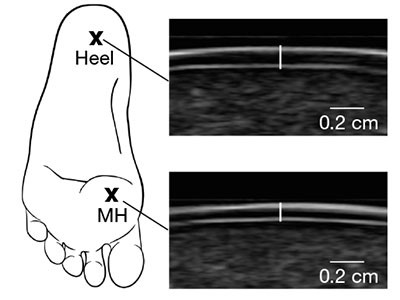
Calloused soles protect our feet, but they also transmit tactile sensation almost as effectively as does soft skin.Credit: Aurelie and Morgan David de Lossy/Getty
The human body is a fluid thing, forever adapting to life’s challenges. The more we exercise, the more our muscles strengthen, and the more our bones remodel themselves in response to the increased loading. The more we work with our hands, the more our skin hardens and thickens. It’s the same with feet. The soles of the feet of people who live barefoot develop calluses — patches of thickened and hardened epidermis — to protect their feet from harm.
This is important because, as one of the few obligate bipeds among mammals, we use our feet a lot. And because we are quite large, as mammals go, our feet take a lot of punishment. Repeated hard contact with the ground takes a toll on the sole.
But do the calluses trade protection for sensitivity? This is the question posed — and answered — by Daniel Lieberman and colleagues in Nature this week (N. B. Holowka et al. Nature https://doi.org/10.1038/s41586-019-1345-6; 2019). Lieberman is an evolutionary biologist with something of an obsession for how we use our feet. The new study put people from Kenya and the United States through their paces on a treadmill and measured sole thickness and responsiveness to vibration. What emerged is that, although calluses protect our feet, they transmit tactile sensation almost as effectively as does soft skin.
Humans have walked barefoot for hundreds of thousands of years. Shoes are a relative novelty, appearing perhaps tens of thousands of years ago and even then as simple sandals or moccasins. The widespread wearing of thick soles and built-up heels is a product of the Industrial Revolution. Platforms, stilettos and trainers have been around for a mayfly blink, in evolutionary terms. Because we wear shoes nearly all the time, our soles are tender — any parent will attest to the pain of treading barefoot on a Lego brick in the small hours of the morning.
As Lieberman and colleagues observe, a person with calloused feet would feel that Lego brick just as acutely. But the researchers also find that bare feet offer a better guide to the force with which our feet strike the ground than do artificially cushioned soles, comfy as those might feel. This difference could have untold consequences for the rest of our skeleton.


 Read the paper: Foot callus thickness does not trade off protection for tactile sensitivity during walking
Read the paper: Foot callus thickness does not trade off protection for tactile sensitivity during walking
 Walking on your sensitive sole
Walking on your sensitive sole
 Barefoot running strikes back
Barefoot running strikes back








